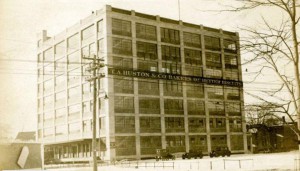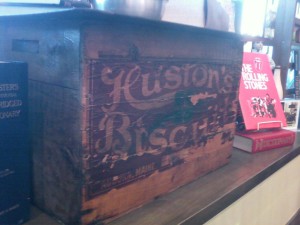You’re sampling a bit of McHuston history every time you bite into a Nabisco cracker.
Baking, it appears, is in the DNA, even if Chef Dustin complains about his results. A young man with shared ancestry named Thomas was driving a bakery truck in Portland, Maine, way back when and put aside a part of his pay each week to save for his dream.
Kept the money in a cracker tin, and when there was enough of it, he bought a modest bakery in Auburn, a small community some thirty miles away. He sent his crackers and biscuits to the Maine boys during the Civil War, and over the next quarter century built up quite a trade. The size of his bakery, the payroll, and number of employees got him a mention in Georgia Merrill’s “History of Androscoggin County” in 1892.
It was about that year that the business burned to the ground.
Undaunted, Thomas Huston moved back to Portland and started over. His “Down East Bakery” at 314 Forest Avenue did well enough that by 1915 he was able to purchase the property and begin construction of what the newspapers later called “a vast industrial wonderland.” He renamed it the T. A. Huston Company. You can see his completed dream in the image.
Accounts at the time called it “a mammoth, sunlit bakery – one of the largest and most completely equipped baking establishments in the East.”
Huston was a visionary, and used flat-slab, steel-reinforced concrete, poured onsite to provide load-bearing capability solid enough to accommodate the four huge ovens. It was not only beyond sturdy: it was also fireproof. That became important later. Article after article recounted the clean, sanitary, and safe conditions found in Huston’s bakery.
Working with his son William Roy, Thomas continued into his later years and – after entertaining an offer – decided to sell out. In 1931, ownership was transferred to the National Biscuit Company: Nabisco.
The building still stands in Portland, but the ovens have gone cold. Nabisco moved its operations out in 1954. After a couple of later sales, the still-stout structure and property was acquired by the University of Southern Maine in 1991.
University President Patricia Plante recognized that the almost-unnaturally massive nature of the construction made it perfect for a project she was cooking up: she used the Rare Book and Manuscript Library at Yale University as a model, and the funding was raised to make the appropriate changes. The new facility was dedicated in October, 1997 as the Albert Brenner Glickman Family Library.
Books.
The building is now on the historic register, and where the Huston ovens once turned out fresh and tasty biscuits and crackers, you’ll find housed a great many book, map, and manuscript collections.
And where books are offered in the Rose District you’ll also find a relic of Thomas A. Huston’s bakery. The wooden biscuit crate dates back to the bakery’s pre-fire days in Auburn and is over a century old – a gift from our resident Huston… Martha.
Thanks, Mom.
Looks great at the front window and reminds me how disparate events and artifacts can be linked through the centuries by the most slender of threads.
We have the books and the lunchtime fare.
Dustin and I are still working on the biscuits.
Come visit!
McHuston
Booksellers & Irish Bistro
Rose District
122 South Main St. Broken Arrow OK!

